US Retailers Accelerate Imports Ahead of Potential East/Gulf Coast Dock Strike

With container shipping moving into its traditional peak season, U.S. retailers are expected to further accelerate shipping ahead of a potential longshore strike that is looking increasingly likely for October 1. The forecast is for strong increases in volume this month coming as many U.S. ports are already running at record levels.
The two sides in the U.S. East and Gulf Coast longshore contract negotiations remain at an impasse with the International Longshoremen’s Association increasing its rhetoric. The employers represented by the U.S. Maritime Alliance issued a statement on Friday calling for the union to come to the negotiating table for the master contract.
The ILA issued a letter to members over the weekend (posted online as well) citing inflation and the need for long-term wage security. The union “outright rejects” the position of the USMX on wages, including the entry level positions, which the employers called “an industry leading wage.” The union is calling for improved pensions, better health coverage, and a hardship provision in its healthcare coverage. Most significantly, the ILA said it wanted to be clear “We don’t want any form of semi-automation or full automation.”
With the union digging in and just three weeks to the contract expiration the National Retail Federation reports retailers have brought forward shipments which contributed they believe in a “bumping up” in June through September import volumes. In addition to the looming strike, they point out fears of “rising tariffs following the election.”
“This is a critical time as retailers prepare for the all-important holiday season, and we need every port in the country working at full capacity. Many retailers have brought cargo in early and shifted to alternate ports as a precaution,” said Jonathan Gold, Vice President for Supply Chain and Customs Policy for the NRF.
The retail trade group raised its September forecast to a total import volume of 2.31 million TEU, which is 10 percent ahead of its forecast in July and up by nearly seven percent over the forecast it issued a month ago. The NRF projects for the third quarter volumes will be up more than seven percent from its outlook two months ago to a total of seven million TEU. Further, the trade group points out that April to October will be a seven-month string of volumes of over two million TEU per month, the first since 2022.
The NRF has kept its forecast for the fourth quarter flat year-over-year. This compares with 20 percent increases year-over-year in July and August.
The rush to bring forward shipments may have contributed to the records reported at many of the top ports in the U.S. The Port of New York and New Jersey, for example, reported its best July ever for total volumes. It was also the seventh busiest month ever for the port. Volume was up 11 percent versus 2023 with NY/NJ handling a total of 806,015 TEU. Similarly, on the West Coast, the two largest ports, the Port of Los Angeles (939,600 TEU) and the Port of Long Beach (882,376 TEU) each reported their busiest July volumes.
The NRF has forecast that U.S. retail sales, excluding automobile dealers, gasoline stations, and restaurants, will be up between 2.5 and 3.5 percent this year. They projected that container imports will be up more than 12 percent for the year to just under 25 million TEU. That would be the third busiest year ever for U.S. imports and just shy of the records in 2021 and 2022 when imports topped 25 million TEU.
No comments:
Post a Comment